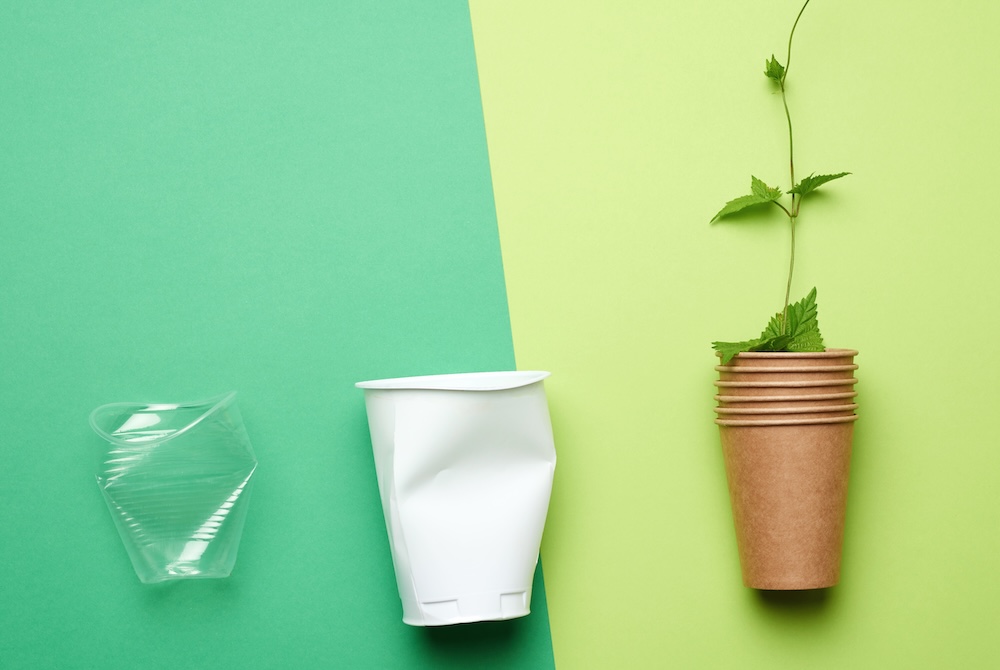They look like paper. They feel like paper. But these sneaky products are lined, coated, or reinforced with plastic — making them recycling and composting nightmares.
The result? Billions of single-use items heading straight to landfills or washing into oceans every year, breaking down into microplastics that will outlive us all.
Here are 10 of the worst offenders — and the real numbers behind their environmental trail.
1. Coffee Cups
What they’re made of: Paper lined with polyethylene (PE) or polylactic acid (PLA) for leak resistance.
Impact: Globally, we throw away an estimated 250–300 billion paper cups each year. Less than 1% are recycled. The rest end up in landfills or oceans, where the plastic lining remains for decades.
2. Takeout Containers and Soup Bowls
What they’re made of: Paperboard with a glossy plastic interior.
Impact: Billions of food containers are tossed annually, with the majority headed to landfill due to contamination and their composite structure. PLA-lined “compostable” versions break down only in industrial composting facilities, which most cities lack.
3. Tea Bags
What they’re made of: Paper reinforced with polypropylene or PET fibers to stop tearing.
Impact: An estimated 100+ billion tea bags are used annually worldwide. Most can’t be composted at home, and their plastic fibers can leach billions of microplastics per cup.
4. Fast Food Wrappers
What they’re made of: Paper coated with plastic films or PFAS “forever chemicals” for grease resistance.
Impact: McDonald’s alone serves over 60 million customers daily, producing mountains of wrappers that either go to landfill or litter waterways.
5. Frozen Food Boxes
What they’re made of: Cardboard with a plastic lining to resist moisture.
Impact: Tens of billions are sold annually, with almost all going to landfill because the lining prevents pulping in standard paper recycling mills.
6. Mailing Envelopes with Plastic Windows
What they’re made of: Paper envelopes with see-through polypropylene film.
Impact: Even if the envelope paper is recyclable, most consumers don’t remove the film, contaminating paper recycling batches.
7. Padded “Paper” Envelopes
What they’re made of: Paper outer layer with bubble wrap or plastic foam inside.
Impact: Millions are shipped daily through e-commerce, ending up in landfill unless fully separated — which is rarely done.
8. Snack and Cereal Box Liners
What they’re made of: Paperboard boxes paired with plastic or foil-lined bags.
Impact: Boxboard is recyclable, but the inner liner is not — and with global snack consumption in the hundreds of billions, that’s a huge waste stream.
9. Paper Plates and Bowls
What they’re made of: Paper with a waterproof plastic coating.
Impact: Often contaminated with food and coated in PE or PLA, these are landfill-bound. U.S. consumers alone throw away an estimated over 100 billion disposable plates each year.
10. Ice Cream Cartons
What they’re made of: Paperboard lined with PE to prevent leaks.
Impact: Almost universally non-recyclable due to their lining and frozen food residue. Tens of billions sold annually = mountains of long-lasting waste.
Why These Items Are So Bad
Once paper and plastic are fused, they require specialized facilities to separate — and those are rare. Instead, they:
- Clog landfills with mixed-material waste
- Pollute waterways, breaking down into microplastics
- Contaminate recycling streams, causing more waste to be trashed
What You Can Do Instead
- Choose true single-material packaging (all-paper, all-cardboard, glass, or metal)
- Bring your own cup, container, or utensils
- Look for “plastic-free” certified packaging — and read the fine print
- Support companies investing in fully compostable, unlined, or reusable systems
Final Thought: One Material, One Future
These products are designed for moments but persist for centuries. The easiest fix? Make it all paper or all plastic — not both. Until then, the “eco-friendly” label on most of these items is just another form of greenwashing.









Reader Interactions